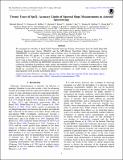| dc.contributor.author | Marsset, Michaël | |
| dc.contributor.author | DeMeo, Francesca E | |
| dc.contributor.author | Binzel, Richard P | |
| dc.contributor.author | Bus, Schelte J | |
| dc.contributor.author | Burbine, Thomas H | |
| dc.contributor.author | Burt, Brian | |
| dc.contributor.author | Moskovitz, Nicholas | |
| dc.contributor.author | Polishook, David | |
| dc.contributor.author | Rivkin, Andrew S | |
| dc.contributor.author | Slivan, Stephen M | |
| dc.contributor.author | Thomas, Cristina | |
| dc.date.accessioned | 2022-01-20T13:53:01Z | |
| dc.date.available | 2021-10-27T19:56:32Z | |
| dc.date.available | 2022-01-20T13:53:01Z | |
| dc.date.issued | 2020-04 | |
| dc.date.submitted | 2020-02 | |
| dc.identifier.issn | 1538-4365 | |
| dc.identifier.issn | 0067-0049 | |
| dc.identifier.uri | https://hdl.handle.net/1721.1/133767.2 | |
| dc.description.abstract | © 2020. The American Astronomical Society. All rights reserved. We examined two decades of SpeX/NASA Infrared Telescope Facility observations from the Small Main-Belt Asteroid Spectroscopic Survey (SMASS) and the MIT-Hawaii Near-Earth Object Spectroscopic Survey (MITHNEOS) to investigate uncertainties and systematic errors in reflectance spectral slope measurements of asteroids. From 628 spectra of 11 solar analogs used for calibration of the asteroid spectra, we derived an uncertainty of σs ′ = 4.2 %, μ m-1 on slope measurements over 0.8-2.4 μm. Air mass contributes to -0.92% μm-1 per 0.1 unit air mass difference between the asteroid and the solar analog and therefore for an overall 2.8% μm-1 slope variability in SMASS and MITHNEOS designed to operate within 1.0-1.3 air mass. No additional observing conditions (including the parallactic angle, seeing, and humidity) were found to contribute systematically to slope change. We discuss implications for asteroid taxonomic classification works. Uncertainties provided in this study should be accounted for in future compositional investigation of small bodies to distinguish intrinsic heterogeneities from possible instrumental effects. | en_US |
| dc.language.iso | en | |
| dc.publisher | American Astronomical Society | en_US |
| dc.relation.isversionof | http://dx.doi.org/10.3847/1538-4365/AB7B5F | en_US |
| dc.rights | Article is made available in accordance with the publisher's policy and may be subject to US copyright law. Please refer to the publisher's site for terms of use. | en_US |
| dc.source | The American Astronomical Society | en_US |
| dc.title | Twenty Years of SpeX: Accuracy Limits of Spectral Slope Measurements in Asteroid Spectroscopy | en_US |
| dc.type | Article | en_US |
| dc.contributor.department | Massachusetts Institute of Technology. Department of Earth, Atmospheric, and Planetary Sciences | |
| dc.relation.journal | Astrophysical Journal Supplement Series | en_US |
| dc.eprint.version | Final published version | en_US |
| dc.type.uri | http://purl.org/eprint/type/JournalArticle | en_US |
| eprint.status | http://purl.org/eprint/status/PeerReviewed | en_US |
| dc.date.updated | 2021-09-14T14:09:58Z | |
| dspace.orderedauthors | Marsset, M; DeMeo, FE; Binzel, RP; Bus, SJ; Burbine, TH; Burt, B; Moskovitz, N; Polishook, D; Rivkin, AS; Slivan, SM; Thomas, C | en_US |
| dspace.date.submission | 2021-09-14T14:10:02Z | |
| mit.journal.volume | 247 | en_US |
| mit.journal.issue | 2 | en_US |
| mit.license | PUBLISHER_POLICY | |
| mit.metadata.status | Authority Work Needed | en_US |
